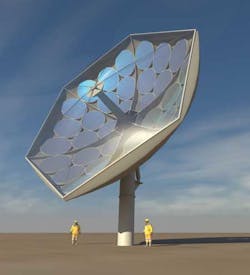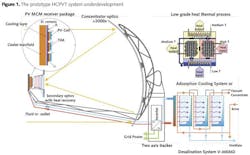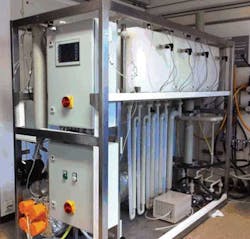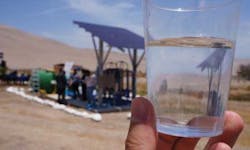Solar Powered Water Desalination Heats Up in Chile
Solar powered water desalination has the potential to dramatically increase access to fresh water in many arid locations. As a solar powered desalination plant opens in Chile - what are the challenges faced in scaling this technology up to full commercial operation? And what potential exists globally for the technology? Andrew Williams investigates.
For thousands of years, people have used the sun's heat to desalinate water - largely through the use of relatively simple evaporative processes. So called 'direct' solar distillation methods have a long history, with evidence that they were used by ancient Greek mariners and Persian alchemists. Basic solar stills are still used in many small desalination and distillation plants. However, while useful at a very small scale, such methods are of limited use in modern agricultural, industrial and urban environments.
In recent years, an increasing amount of attention has been paid to 'indirect' solar desalination using modern solar photovoltaic technology alongside methods such as reverse osmosis (RO) and Multiple Effect Distillation (MED), which have the potential to operate at a much larger scale.
According to Dr. Corrado Sommariva, managing director of ILF Consulting Engineers Middle East and president of the International Desalination Association (IDA), a 'large spectrum' of technologies could be classified as “solar powered desalination" - mainly because most traditional state of the art desalination technologies could in theory be coupled with solar powered energy sources.
In the past, some initial research efforts have focused on the viability of solar-thermal powered desalination plants, as well on how to combine sea water reverse osmosis (SWRO) processes with solar photovoltaic technology. However, Sommariva argues that solar powered approaches of this type are 'generally difficult' to manage alongside traditional desalination technologies due to their 'very large energy footprint.'
“This is the reason why there is a new interest towards new technologies that would be able to ensure a lower energy footprint, as this would also facilitate matching with renewable energy sources," he says. In this respect, Sommariva believes that a few technologies are 'particularly interesting,' including Membrane Distillation and Low Temperature Distillation, which he says offer 'great potential for coupling with either solar panels or solar ponds.'
“Multiple Effect Distillation (MED) plants have already been coupled with solar ponds," he says. “For SWRO or membrane based technologies, the matching with photovoltaic becomes interesting when the energy footprint goes below the traditional state of the art values and when there is a system that is capable of power import [and] export during the day-night period, as well as during the peak and off peak periods, so that the overall energy balance to the grid remains neutral," he says.
Desert Projects
Such potential is now beginning to come to fruition. In an effort to use the country's sizeable solar energy resource to assist the local agricultural community, membrane-based technologies of the type mentioned by Sommariva have recently been employed in Chile. The demonstration facility, established in mid-March at the Padre Francisco Napolitano agricultural school in the Lluta Valley, uses membrane separation technology to remove salt from water and is wholly powered by an array of solar photovoltaic panels.
The project was established by the Chilean government-supported Fundación Chile, via its Climate Change Fund, and backed by Chile's national Innovation Fund for Competitiveness (FIC).
For many years, farmers in the region, located in the arid Arica y Parinacota Region of the country, have found it difficult to manage crop irrigation - largely because access to water is very low, with any water that is available often being too brackish for agricultural purposes.
According to the project manager, Carolina Cuevas Gutierrez of Fundación Chile, although the plant is currently in an evaluation phase it is already clear that the water generated from the plant has a decreased salinity and boron content. She is confident will enable “an increase in quality and diversity of crops in the region".
In a press statement, Fundación Chile said that the plant is “simple in its construction and operation" and costs only US$210,000 (CLP 100 million) to build.
Over the coming months the plant's operations will be closely monitored. A market study and business model will be created - with the ultimate aim being to commercialise the technology for use at other locations across northern Chile.
“The benefit lies not only in the new water technology, but also the low energy consumption," Gutierrez. “As we know, energy represents the biggest cost in any technology. Using today's solar technology, we can produce excellent quality water, and the next step is to apply this to further agricultural production."
Prof. André Bernard, head of the Institute for Micro- and Nanotechnology (MNT) at the Interstate University of Applied Sciences Buchs (NTB) in Switzerland, adds: “This is good news. Clean drinking water is a very precious good – and all efforts to produce it where needed is key to a self-supporting micro-economy."
Elsewhere, an IDA and ILF-led energy task force is also supporting a MASDAR initiative, which aims to install up to five pilot solar-powered desalination plants in the Emirates of Abu Dhabi. The plan is for these facilities to use the type of new desalination technologies that Sommariva describes as having a low energy footprint, and which he is confident can therefore 'be easily matched with renewable energy sources.'
“Among various renewable sources, we are contemplating mainly solar and geothermal. Recently a MED plant driven by an enhanced solar pond has been commissioned in Fujairah. Saudi Arabia has [also] launched a massive program for renewable driven desalination in the Al Khafji area," he says. “In general there are very interesting movements that hopefully will drive the new generation of low energy desalination plant[s]," he adds.
IBM Research
In another development, IBM Research is currently heading up a research project investigating the use of heat from a concentrated photovoltaic (CPV) system to drive a membrane distillation (MD) desalination process.
The prototype High Concentration PhotoVoltaic Thermal (HCPVT) system uses a large parabolic dish, constructed from a large array of mirror facets, which are attached to a sun tracking system. This tracking system positions the dish at the optimum angle to capture solar radiation, which then reflects off the mirrors onto several microchannel-liquid cooled receivers with triple junction photovoltaic chips. To capture the medium grade heat IBM scientists and engineers have made use of technology initially developed for water-cooled high performance computers. Here water is used to absorb heat from the processor chips, which is then used to provide space heating for IBM facilities.
In the HCPVT system, instead of heating a building, the 90° Celsius water will be used to heat salty water that is passed through a porous membrane distillation system where it is vaporized and desalinated. IBM estimates that such a system could provide 30-40 litres of drinkable water per square meter of receiver area per day, while still generating electricity with a more than 25% yield, or two kilowatt hours per day.
According to Bruno Michel, manager - Advanced Thermal Packaging at IBM Research, the reason for choosing a HCPVT system is that it provides 80-90° C waste heat - a temperature level which matches exactly 'with the required temperature for an optimal yield of an MD system.'
“Water evaporates at reduced pressure through the pores of a membrane, like the well known GoreTex membrane, that allows steam to pass but not water," says Michel. “The steam then condenses on a condensation foil that transfers the heat to the next effect. This multi-effect approach maximizes the yield for the distillation process," he adds.
IBM's partners, Airlight Energy, will develop this part of the system using low cost concrete and simple pressurized metalized plastic foils - with ETH Zurich assuming responsibility for the development of the solar concentrating optics. Under the auspices of the project, prototype HCPVT systems will be built in Zurich, Biasca and Rueschlikon over the next 36 months.
“The water desalination is already being prototyped here at the lab in Rueschlikon using a small photovoltaic dish we have on the roof," says Michel. Meanwhile, Bernard is keen to stress that, in contrast to the Chilean Solar Power Desalination Plant - which converts sunlight into electrical power that is used for the desalination process - the HCPVT project uses excess heat energy to desalinate water.
“The IBM-Airlight HCPVT-system will, however, employ larger area solar collectors and concentrators that are less suitable for small-scale plants that fit into a 'private garden,'" he says.
The Scale Up Challenge
Although projects of the type outlined here show a great deal of promise, a number of hurdles must still be overcome before the various types of solar powered desalination technology can reach large-scale commercialisation. For Sommariva, the main problem encountered so far relates to “bridging the gap between research and development and commercialisation of these concepts". In his view, the main challenge is that these concepts need time and operational feedback before they will be able to compete with state of the art technology “in terms of robustness, reliability and maintainability".
“Ultimately the bankability of these concepts becomes problematic. An important step ahead is [to undertake] a continuous and rigorous piloting program which is aimed at commercialisation," he says.
However, to ensure that these concepts are 'induced adequately' in the market, Sommariva also argues that the first attempts at commercialisation need to be made within an 'initially restricted market' where renewable desalination projects of this type 'can compete in a restricted arena without being forced to compete with the large IWP-IWPP projects involving traditional technologies.'
“In this way, the premises for technology development and industrial implementation based on purely commercial criteria can be created," he says.
Michel adds that the main challenges for technologies of the type developed in the HCPVT project are maturization and cost - and he stresses that the technology is new and “needs to catch up with established technologies".
“Despite the fast track development we have to pay attention to select low-cost components," he says. “The selected technologies, micro-channel cooled multichip receivers and inflated optics with injection moulded concrete elements are our winning bets to overcome the challenges," he says.
Meanwhile, Nicolas Zäch, project leader for the HCPVT System project at NTB, believes that an important factor in the ongoing commercial viability of plants such as those established in Chile is the availability of cost-efficient solar cells, along with smart low-cost tracking systems. “Another aspect is an energy-conservative desalination process that can be driven using the solar power. Knowing the energy needed for the desired desalination output helps to configure the solar cells correctly and finding the appropriate PV technology," he says.
Future Prospects
Looking ahead, Sommariva hopes that indirect solar powered desalination will become increasingly viable “all over the world". However, he points out that in locations such as the Middle East energy costs are still often 'unrealistic' - a situation which he argues 'clearly does not help in driving desalination towards efficiency or towards renewable solutions.'
“This will change in the future as the cost of water will be more and more dependent on the cost of energy," he says. Michel also envisions the HCPVT system providing sustainable energy and potable water to locations around the world, including southern Europe, Africa, the Arabian peninsula, the south-western part of the United States, South America and Australia. He points out that remote tourism locations are also an 'interesting market,' particularly resorts on small islands, such as the Maldives, Seychelles and Mauritius, “since conventional systems require separate units, with consequent loss in efficiency and increased cost".
In the long run, Bernard is confident that the prospect of becoming independent from global clean water suppliers 'will help poorer regions to develop and prosper quicker' and at the same time 'increase their knowledge in technology.'
“This is important for a region and a country in general. But of course solar-driven desalination is not the golden egg for all regions, since it dependent on high insolation," he says.
Author's note: Andrew Williams is a freelance correspondent for WWi magazine. For more information, email: [email protected].






